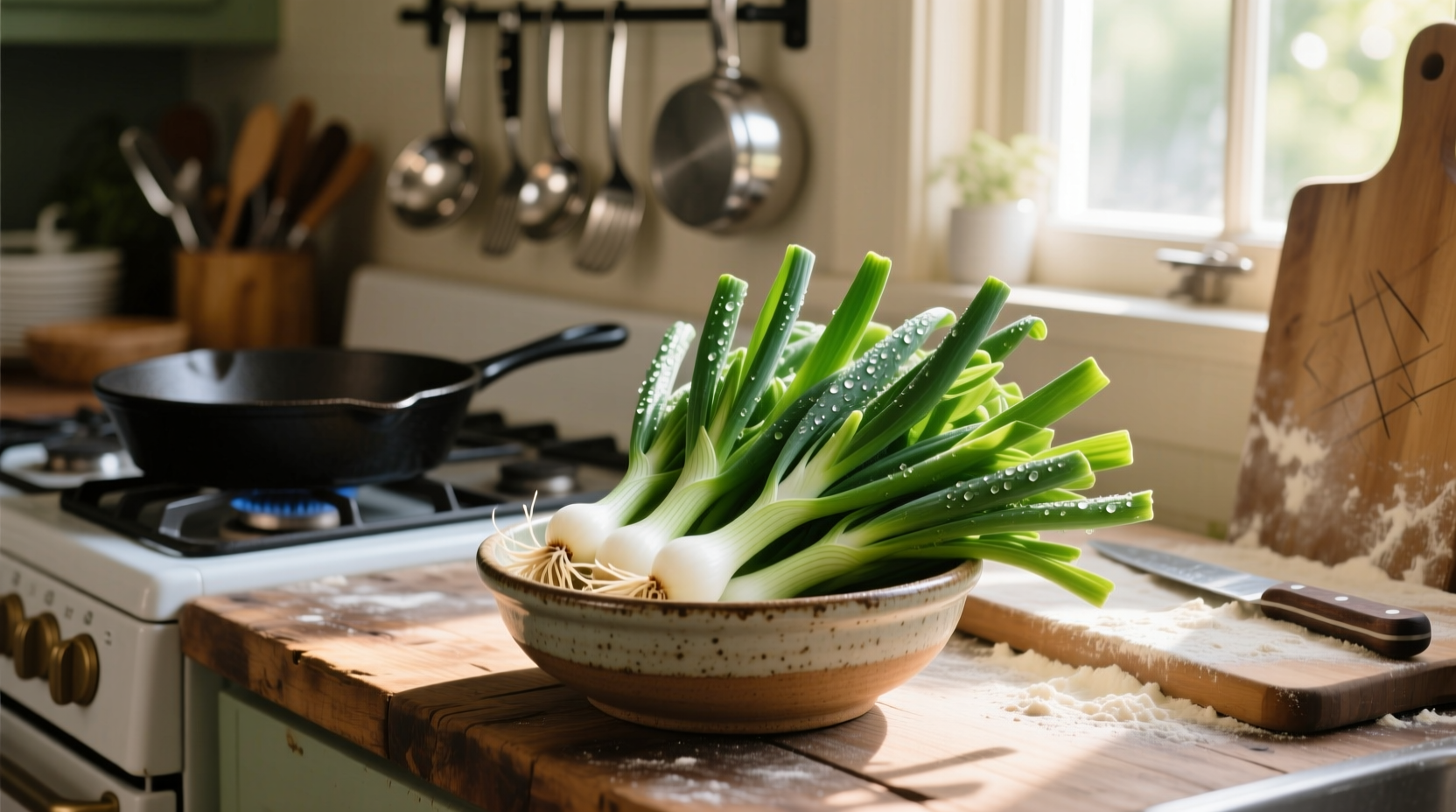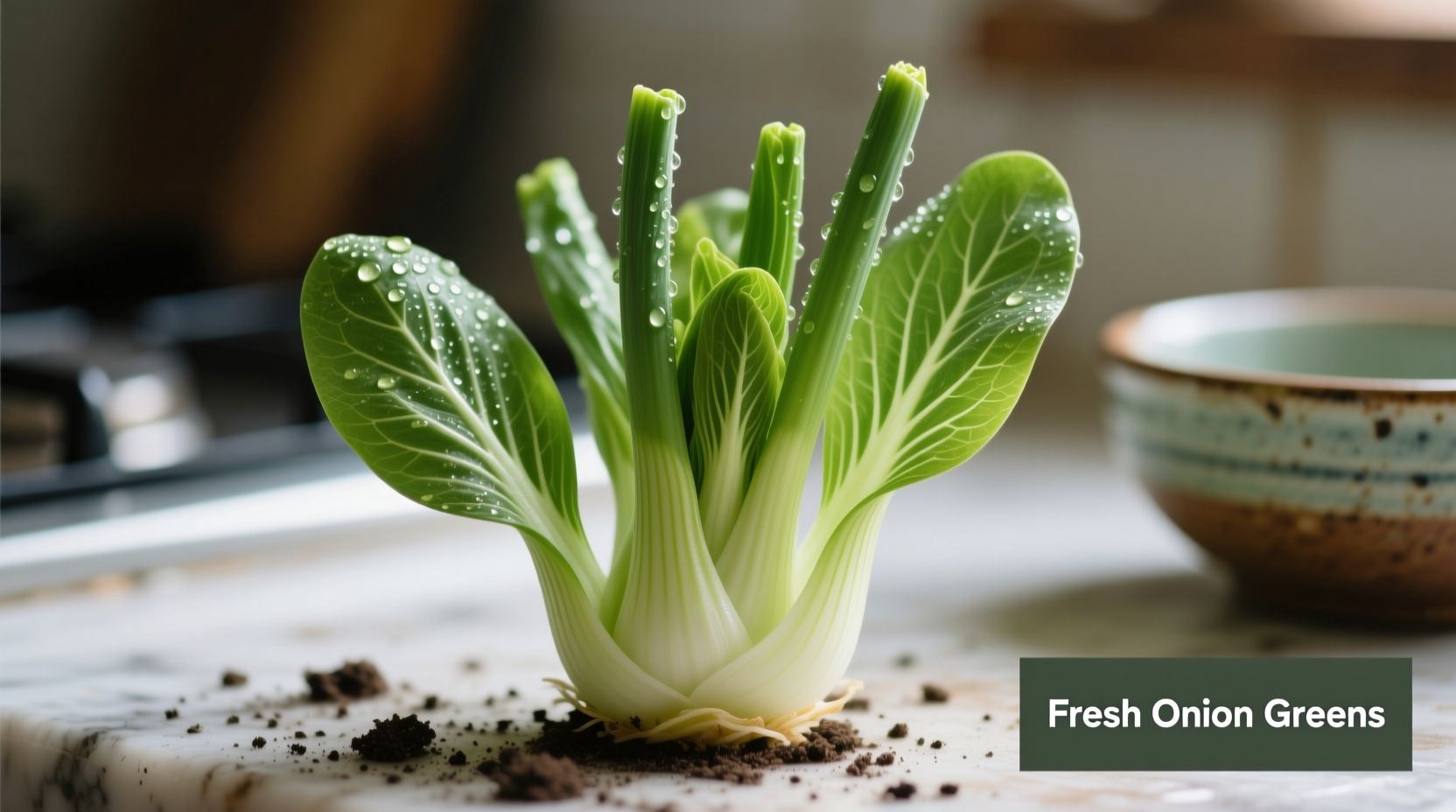Onion greens, also known as scallion tops or spring onion leaves, are the long, hollow green stalks that grow above ground from onion bulbs. They offer a mild, fresh onion flavor with subtle grassy notes, making them perfect for garnishing, salads, and cooked dishes without overwhelming other ingredients. Unlike mature onions, they contain no bulb but deliver significant nutritional benefits including vitamins A, C, and K, plus antioxidants that support immune function and bone health.
When you spot those vibrant green stalks growing from your garden onions or bundled at the farmers market, you're looking at a culinary treasure most home cooks underutilize. These slender green tubes aren't just decorative—they're packed with flavor and nutrients that can elevate everyday dishes from ordinary to extraordinary. Professional chefs consistently reach for onion greens when they want fresh onion flavor without the sharp bite of mature bulbs.
What Exactly Are Onion Greens?
Onion greens represent the leafy portion of young onion plants, harvested before the bulb fully develops. They grow from several onion varieties including:
- Spring onions (harvested early with small bulbs)
- Scallions (typically bulbless varieties)
- Green onions (often used interchangeably with scallions)
- Overgrown storage onions that have begun sprouting
Unlike mature onions where the flavor concentrates in the bulb, onion greens distribute their milder flavor throughout the entire stalk. The lower portion near where a bulb would form offers slightly stronger onion notes, while the upper green sections provide a more delicate, grassy flavor.
| Ingredient | Flavor Profile | Best Culinary Uses | Storage Duration |
|---|---|---|---|
| Onion greens | Mild, fresh, grassy onion notes | Garnishes, salads, stir-fries, soups | 7-10 days refrigerated |
| Chives | Delicate, subtle onion flavor | Finishing touch, dips, potato dishes | 5-7 days refrigerated |
| Leeks | Sweet, mild onion flavor | Soups, stews, sautéed dishes | 10-14 days refrigerated |
| Mature onions | Sharp, pungent, varying sweetness | Caramelizing, roasting, base for sauces | 1-3 months stored properly |
Nutritional Powerhouse in Green Packaging
According to research from the USDA National Nutrient Database, onion greens deliver impressive nutritional benefits per 100g serving:
- Vitamin K: 207% of daily value (essential for blood clotting and bone health)
- Vitamin A: 20% of daily value (supports vision and immune function)
- Vitamin C: 15% of daily value (antioxidant and immune booster)
- Folate: 12% of daily value (crucial for cell function and tissue growth)
- Calcium and iron in meaningful amounts
These nutrient levels significantly exceed those found in mature onion bulbs, making the greens the nutritional powerhouse of the plant. The vibrant green color indicates high chlorophyll content, which works synergistically with other compounds to provide antioxidant benefits.
How to Select and Store Onion Greens Properly
When choosing onion greens at your local market, look for these quality indicators:
- Bright green color without yellowing or browning
- Firm, crisp texture that springs back when bent
- No slimy spots or wilting appearance
- Fresh, clean scent without mustiness
Proper storage extends their shelf life significantly. The University of California Agriculture and Natural Resources recommends:
- Trim any damaged ends
- Stand upright in a glass with 1-2 inches of water
- Cover loosely with a plastic bag
- Store in refrigerator
- Change water every 2-3 days
This method maintains freshness for 7-10 days, compared to just 3-4 days when stored loose in a plastic bag. For longer preservation, chop and freeze in ice cube trays with water or oil for future cooking applications.

Culinary Applications That Shine
Professional chefs utilize onion greens in specific ways that home cooks can easily replicate. The key is understanding how their delicate flavor profile works in different cooking scenarios:
Raw Applications
When used raw, onion greens provide:
- Perfect garnish for soups, stews, and baked potatoes
- Essential component in Asian dipping sauces
- Flavorful addition to salads and slaws
- Base for compound butters and herb oils
For raw applications, slice thinly on a sharp diagonal to maximize surface area while maintaining visual appeal. The lower white portion offers more pronounced flavor, while the green tips provide subtle notes.
Cooked Applications
When cooking with onion greens, timing matters:
- Add to stir-fries during the last 30-60 seconds of cooking
- Stir into soups and stews just before serving
- Use as a pizza topping after baking for fresh flavor
- Blend into omelets during the final minute of cooking
Overcooking destroys their delicate flavor and vibrant color. The sweet spot is brief exposure to heat that wilts them slightly while preserving their fresh character.
Common Mistakes to Avoid
Even experienced home cooks make these errors with onion greens:
- Discarding the entire stalk - Both white and green portions are edible, though with varying intensity
- Using as direct substitute for mature onions - Their milder flavor won't provide the same depth in recipes requiring cooked onions
- Adding too early in cooking process - Heat destroys their delicate flavor profile
- Storing improperly - Loose in plastic bags leads to rapid moisture loss and spoilage
Understanding these limitations helps you use onion greens effectively. They complement rather than replace mature onions in most recipes, adding freshness where stronger onion flavor would be overwhelming.
When Onion Greens Shine Best
Certain dishes particularly benefit from onion greens' unique properties:
- Asian noodle dishes where strong onion flavor would dominate
- Fish and seafood preparations needing subtle allium notes
- Spring and summer salads requiring fresh onion flavor
- Deviled eggs and potato salads for visual appeal and mild flavor
- Breakfast dishes like omelets and frittatas
They're less suitable for dishes requiring deep caramelization or where onion forms the flavor foundation, such as French onion soup or onion jam. Recognizing these context boundaries ensures you use them where they'll have maximum impact.
Simple Recipe to Try Tonight
Lemon-Garlic Shrimp with Onion Greens
- Sauté 1 lb shrimp in 1 tbsp olive oil until pink
- Add 2 minced garlic cloves and cook 30 seconds
- Stir in juice of 1 lemon and 2 tbsp white wine
- Remove from heat and fold in 3 chopped onion greens
- Serve over rice or quinoa with additional greens on top
This 15-minute dish showcases how onion greens provide fresh flavor without overpowering delicate seafood. The lower white portions add subtle onion notes while the green tips contribute visual appeal and a hint of grassiness.











 浙公网安备
33010002000092号
浙公网安备
33010002000092号 浙B2-20120091-4
浙B2-20120091-4